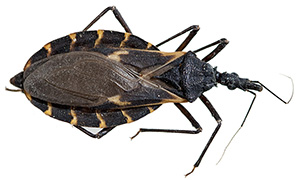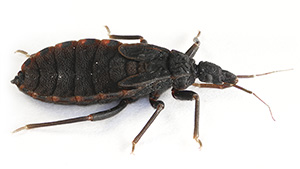Kissing Bug
 |
COMMON NAMES: Big Bed Bug, Bloodsucking Cone Nose, Cone Nose Bug, Kissing Bug, Mexican Bed Bug, Bloodsucker
SCIENTIFIC NAME: Order Heteroptera, Family Reduviidae, Triatoma protracta
BODY LENGTH: Adult--3/4" to 1"
IDENTIFICATION: Dark brown, almost black. Broad, flat abdomen with yellow markings along edges. The head is long and conical. The thorax is narrow in front. Wings form a distinctive “x”.
A Kissing Bug can be recognized by its cone-shaped head, thin antennae and thin legs. Each species found in the U.S. is mainly black or very dark brown, with red, orange or yellow stripes on the edge of their backs.
BIOLOGY AND LIFE CYCLE: Eggs are laid in sheltered places. Nymphs hatch and grow slowly into adults. They may feed on insects. Usually one generation per year. Incomplete metamorphosis.HABITAT: Found in poultry houses and horse stalls.
FEEDING HABITS: The normal diet of the kissing bug is bed bugs. They also suck blood from poultry and other animals and humans as a last resort.
ECONOMIC: Spread of Chagas disease.
NATURAL CONTROL: Good screens on windows and doors of homes. Caulk and seal cracks and crevices.
ORGANIC CONTROL: Diatomaceous earth, orange oil and plant oil sprays. Pest control companies can take care of this bug with essential oil products and other non-toxic products. Vacuuming more thoroughly than normal will also help.
INSIGHT: This is not the true bed bug and is the outlaw of the assassin bug family. Some species of the kissing bug are known to inflict a very painful bite with a considerable number of ill effects that may last weeks. Usually the bite from the kissing bug is on the lips, eyelids or ears of sleeping victims and is painless.
The normal diet of these bloodsuckers is bed bugs (Cimex lectularius), small bugs that suck blood from poultry or people at night and then hide during the day. If the bloodsucker gets in your house and finds no bed bugs, then you become the target.
If you wake up some morning and have a big welt that is about the size of a quarter or larger and that doesn't hurt but itches like the devil, you probably donated a little blood to this demon. Start taking apart the bedding and drapes because it's hiding there somewhere; if you don't find it, you will wake up the next morning with another itchy welt. Do not scratch. Wash the swelling and surrounding area thoroughly with soap and water--then it will be okay to scratch. This bug carries a deadly sleeping sickness called Chagas disease. It doesn't inject the disease organisms while sucking your blood; they are carried in the bug's feces. If you scratch without first washing, you may infect yourself. In the South, the bug deposits feces near the bite. But the farther north the bug goes, the farther it deposits its feces from the bite, making infection less likely with scratching.
When the bloodsucker decides to have dinner on you, it is usually at night. It doesn't want to be disturbed, so it carefully walks lightly over your body, so lightly you can't feel it. When it finds the location for its banquet, it uses a strong anesthetic on the spot. Then it will sit there and pig out until it's full as a balloon and you won't feel a thing.
The bloodsucker can also use its sucking snout to sting when it feels a need for defense. The sting can be extremely intense, and the effects may last for weeks or months.
Search Library Topics Search Newspaper Columns


